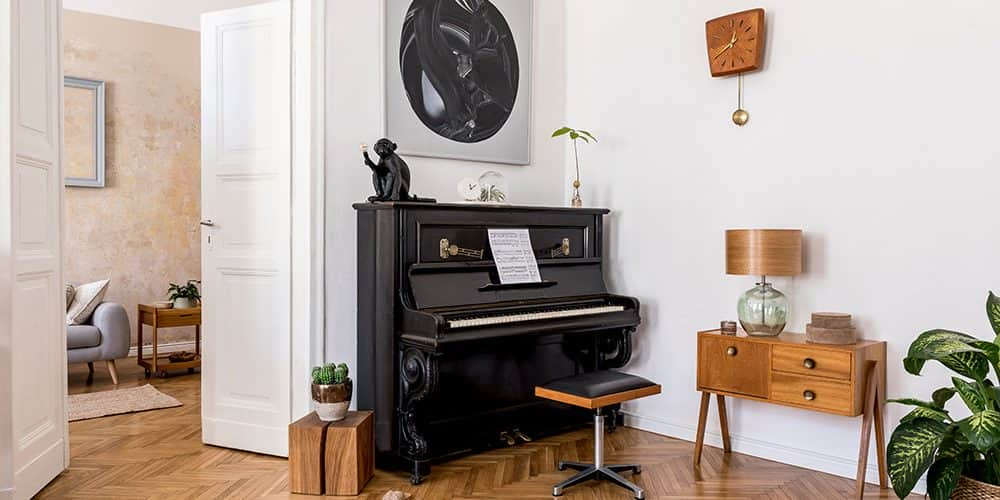Are you moving a piano? Here are some tips on how to do it safely. Pianos are heavy and delicate instruments, so it’s important to be careful when moving them. With a little planning and the right equipment, you can move your piano without damage. Read on for our tips on how to move a piano. Thanks for reading!
What to consider before moving your piano.
Moving a piano can be a daunting task, and it is important to consider multiple factors before attempting to transport your piano. Measurements of the space you’re moving from as well as the space you’re moving to should be taken into consideration. Make sure there is enough room for the piano and that any turns on the way are wide enough – this could require the removal of door frames or other furniture. The weight of the instrument must also be factored in; not only is it possible that you don’t have the people required to move it but if using pro movers make sure they have appropriate tools such as a ramp or pulleys that allow them to move safely and efficiently. Lastly, check your piano’s condition – repair any broken parts before moving so that damage during transportation can be avoided. Taking these simple steps will help guarantee the safe arrival of your instrument at its new home.
Bring the right materials to move a piano
Moving a piano can be daunting but the right materials will make the process much smoother. Before you begin, protect your floor by laying down blankets or bubble wrap on either side of the piano’s path. Additionally, protect walls and furniture as you manoeuvre the piano around any tight spaces. To protect your back, use a dolly to move heavy pianos and consider using two instead of one when navigating stairs. Use ratchet straps to keep the piano strapped onto the dolly for added stability. When loading the piano, have a friend help you lift it into the moving space or vehicle using several or all of these steps for successful completion!
How to move an upright piano.
Moving an upright piano can be incredibly intimidating and challenging, but with the right approach, it can become a fairly straightforward process. The first important step is to prepare the piano for moving by ensuring the lid, pedals and strings are secure, then move any items off of or around the piano. Next, remove the legs carefully and wrap them as well as the keyboard and action securely in blankets. Once everything is secured you will want to move the piano onto a dolly, taking care not to damage floors or doorways on its way out. With two or more people gently walking the dolly away from any obstacles that have been cleared prior; lifting must be done as little as possible during this process. Finally, finish up by unloading your upright piano at its new home – congratulations!
How to move a grand piano.
Moving a grand piano can be a daunting task for anyone who hasn’t navigated the process before. It’s essential to consider all the steps necessary from start to finish, as even minor details can make a difference. Despite the size and weight of a grand piano, it’s possible to move it with professional assistance and extra help from friends or family. Before getting started, it’s important to prepare protective material such as felt pads, towels, and blankets that will physically protect the instrument during transport. Once you’ve secured the materials, ensure that you cover all sharp edges before moving your grand piano. Working with a team of professionals who specialize in transporting pianos is ideal when planning to move an expensive or antique model. With careful planning and the right assistance, you’ll soon have your beloved instrument in its new home without any harm done!
The most common mistakes when transporting a piano.
Moving a piano is no easy task, and it’s not something that should be taken lightly. It requires planning, skill, and an understanding of the basics to make sure nothing goes wrong. Common mistakes when transporting a piano include not measuring the size of entryways, neglecting to properly secure items in transit, carrying excessively heavy loads without assistance, and taking shortcuts during transitions. Careless handling can majorly damage pianos as they are quite delicate instruments – so it is essential to plan out the move before undertaking it. Understanding the potential risks and being proactive about avoiding them will ensure a safe journey for your beloved instrument.
Moving a piano yourself vs. Hiring a company.
When it comes to moving a piano, many people face the tough decision of whether to do it themselves or hire a company. Doing it on your own may save on cost, but it usually also takes longer and requires equipment and supplies that most people don’t have handy. Hiring a professional agency can help make the process significantly smoother and faster, although you will need to consider the expense upfront. Similarly, attempting to move a piano by yourself could lead to trying to hurry through the task and risk causing serious damage. Finding the right balance between the time involved and equipment needed versus budget is an important factor in determining which option is best for you.
Conclusion
If you’re considering moving a piano, there are a few things you should take into consideration first. Make sure to have the right materials on hand and know how to properly transport an upright or grand piano. To avoid making common mistakes, it’s best to hire a professional company like Mitchells Moving Company which can safely and efficiently get the job done. Contact us today for more information or to request a free quote.

